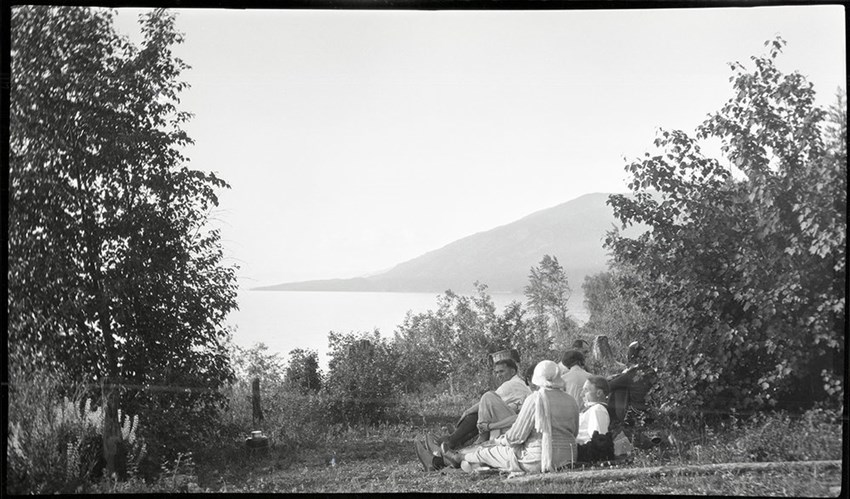How Community Investment in 1899 Made the FLBS Dream a Reality
Imagine, if you will, a world without the Flathead Lake Biological Station. If not for the generosity of the Missoula community back in 1899, that might have been the case.
In the fall of 1897, University of Montana’s (UM) first professor of biology, Morton J. Elrod, headed north on an exploratory sampling trip into the Flathead Watershed. This marked the very first field excursion by anyone from the fledgling university, and Elrod was instantly enamored by the breathtaking expanse of Flathead Lake and the encompassing mountainous ecosystems. Elrod wanted to find a secluded place where people could study the natural world. He knew of other field stations in development elsewhere in the country and around the world, and saw an enormous need and benefit to create such a facility in Montana.
Upon returning from his trip to the Flathead Watershed, Elrod believed he had found the perfect future home for his biological station, which would provide immersive research and educational opportunities for scientists and community members alike.
The following spring, Elrod returned to Flathead Lake to search for a site for a new bio station. After exploring every bay and cove along a one-hundred mile stretch of Flathead Lake’s shoreline, Elrod found a few suitable locations, but most lacked the necessary protection from the weather and waves of the open lake.
Finally, Elrod met with a man named Everit L. Sliter, who owned a five-acre plot of land located about half a mile north from where the Swan River flows into Flathead Lake. At the time, a small building on the bank of the Swan River and two log houses were the only structures at this location, which a few years later, in 1901, would be formally established as the town of Bigfork, MT. UM reached an agreement with Sliter on a six-year lease to use some of the land and the buildings, and Montana’s biological station took one step closer to becoming a reality.

By the early 1900s, the community of Bigfork, MT was beginning to develop next to the Bio Station’s original site on the Swan River. By 1910, the Bio Station had relocated to its current Yellow Bay location.
But there was one final hurdle to clear before the station could officially begin operations. While having a site on a freshwater lake in a pristine mountain ecosystem made for an ideal setting, funding for the station was largely in question.
Initially, the bio station was going to be a collaboration between UM (founded in 1893 as the State University of Montana in Missoula) and Montana State University (founded in 1893 as the Agricultural College of the State of Montana in Bozeman). The schools planned on alternating years of study and research at the station, and the cost of the station’s establishment—which was estimated to be between $700 and $800—would be shared between the two institutions.
In-state rivalry aside, sharing the financial startup costs was an ideal scenario for both UM and MSU. Both were only a few years old at the time and—along with University of Montana Western (founded in 1897 as the State Normal School in Dillon)—were using the bulk of their state funding to develop programs and buildings on their own respective campuses.
Before the partnership could come to fruition, however, the bio station’s driving supporter in Bozeman—a biologist named E. V. Wilcox—left Montana for a position at another institution. Montana State University opted not to provide support for the upstart field station in northwest Montana, leaving the University of Montana with a difficult decision: Forgo the station altogether, or find a way to fund it alone.
Fortunately, UM chose the latter, and the community of Missoula would rise to the occasion. In what would become the bio station’s first fundraiser, Missoulians contributed $750 to the bio station’s startup costs. The generosity was so overwhelming, that the station named its first research vessel—a 16-foot, 8-person capacity boat with a canopy top and side curtains—the Missoula.

The Missoula was named in honor of Missoula’s residents, who generously provided pivotal philanthropic funding that covered the Bio Station’s startup costs in 1899.
By the spring of 1899, thanks to UM’s commitment and the philanthropic investment of local Montanans, the bio station had a home and research infrastructure, and the State Board of Education officially established UM’s Flathead Lake Biological Station (FLBS).
FLBS utilized $125 of the philanthropic funds to build a small laboratory called the River House (still standing in Bigfork today, although it has been remodeled several times) which could accommodate twelve students; $35 for a 16-foot wooden rowboat called the Culex (the scientific name of mosquitos common in the area); and $350 for the Missoula, which was also the first boat on Flathead Lake with a gasoline engine (previous boats on the lake were powered by steam engines). Soon thereafter, the bio station added a 14-foot canvas boat called the Daphnia (named for the abundant Daphnia pulex, a freshwater flea).
Today, thanks in large part to continued philanthropic investment, FLBS has grown to have more than sixty buildings on eighty acres in Yellow Bay, and has accommodation for over 100 students and researchers. Our research fleet entails more than twenty boats (if you count canoes and kayaks), and includes a 30-foot research vessel, the Jessie B.
Similar to back when we were founded, philanthropic funding remains essential to our functionality, growth, and our timeless mission to serve as the Sentinel of the Lake. Every achievement and innovation at FLBS wouldn’t be possible without the continued support of the Bio Station community, a group that has been making it possible for us to help keep our waters blue for 125 years.


